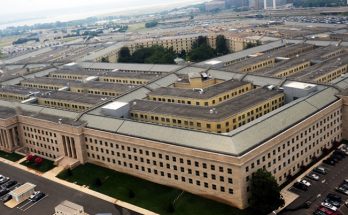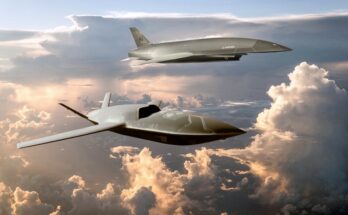In what has been described by Australian Prime Minister Anthony Albanese as the “biggest single investment in Australia’s defense capability in all our history,” Albanese and his counterparts from the U.S. and U.K. laid out a decades-long plan for Australia to acquire and operate conventionally armed nuclear-powered submarines.
The announcement follows the earlier shock revelation back in September 2021, when Australia opted to cancel its plans for 12 French-designed conventional submarines and instead utilize American and British nuclear-powered technology for its future fleet as part of a trilateral technology-sharing and security pact referred to as AUKUS.
The larger AUKUS treaty covers diplomatic, security, and defense cooperation in the contested South China Sea as well as joint work on cybersecurity, artificial intelligence, quantum technologies, and undersea capabilities.
But it is the technology-sharing element of the multibillion-dollar submarine project that immediately captured global attention.
The decision to scrap the AUD90 billion ($66 billion) deal with France and go for the nuclear option came down to two issues: mounting frustration with French shipbuilder Naval Group and a regional security environment that continues to shift at rapid pace.
Though the Australian decision incurred immediate diplomatic fallout with Paris, the move towards ever-closer security alignment with Washington and London signaled like-minded views between the three partners regarding China.
All three nations perceive China under Xi Jinping to be a significant threat across the near and far security horizons. Whether it is China’s military buildup, naval expansion, and bullying presence in the South China Sea, its debt diplomacy, intellectual theft, economic and diplomatic coercion campaigns, or its cyber-aggression, all three nations are attempting to move in accordance against a gathering concern.
Now, with roughly 18 months having gone by and countless talks and consultation studies undertaken, key details regarding Australia’s and its partners’ plans have emerged.
It’s an exciting time to be in #AusNavy with the Australian Government today announcing the Optimal Pathway for Australia to acquire a conventionally-armed, nuclear-powered submarine (SSN) capability from as soon as the early 2030s, under the #AUKUS partnership. 🇦🇺🇬🇧🇺🇸 pic.twitter.com/Jt0ayMJxoY
— Chief of Navy Australia (@CN_Australia) March 14, 2023
The first stage in how things will unfold involves U.S. help in enabling Australian personnel to stand-up the infrastructure and know-how to maintain and operate nuclear-powered submarines (SSNs). Thus far, the Royal Australian Navy (RAN) and domestic shipyards only have experience with conventional submarines.
In addition, Australian shipbuilders will fan out to U.S. and U.K. facilities to get hands-on experience in how to build SSNs, while Australian naval specialists will be embedded on American and British submarines and attend military academies enabling them to learn how to operate such vessels.
During this same time the U.S. Navy and their Royal Navy counterparts will begin what has been dubbed as “submarine rotational force west,” involving the forward deployment of as many as four U.S. and one British submarine to Perth on Australia’s southwestern coast. This will provide Australian personnel with the opportunity to begin learning how to manage such vessels, while providing the U.S. with a strategic locale to use as a submarine repair hub, as well as a base for launching missions in the Indo-Pacific region.
The U.S. and U.K. submarine rotations to Perth will begin as soon as 2027.
The second stage will launch in the early 2030s and involve an Australian purchase of at least three Virginia class SSNs, possibly as many as five if an option for two additional submarines is picked up. These will either be new-build or drawn from U.S. Navy stocks. The figure will depend on how progress on the third and final stage is perceived. Should excessive delays be expected, the Australian government would pull the trigger on the two-boat option to ensure adequate RAN submarine capacity.
The final stage is to involve the production of a clean-sheet design initially titled SSN AUKUS. The design will be based on a replacement model for the Royal Navy’s current Astute class fleet but involve significant amounts of American technology derived from the Virginia class. By combining three elements – British ship design, American nuclear submarine technologies, and Australian naval industry – the synergies created will enable integration of know-how, supply chains, and ship servicing.
In essence, the strategic value would offset the hurdles and complications anticipated in the multi-pronged initiative.
Nonetheless, the path forward is expected to be winding.
The British Astute-replacement program – currently referred to as Submarine Ship Nuclear Replacement, or SSN(R) – received its first seed funding in September 2021 when the British Ministry of Defense announced £170 million ($206 million) for long-lead design work. That announcement came shortly after the AUKUS agreement was revealed. The new class will feature a vertical launch system (VLS), enabling the submarines to carry new missile types and interoperate more smoothly with their U.S. Navy counterparts and ensuring supply chain resilience with its transatlantic partner.
The next-generation British submarines are intended to enter Royal Navy service by the end of the 2030s. The Australian side would then begin producing its own SSN AUKUS variants in the early 2040s.
From now until then, difficult questions involving funding (Australia expects to invest somewhere in the area of AUD230 billion – or around $150 billion – in the overall project, though many estimates place this total far higher); U.S. legal, political, and industrial hurdles; and the need for the British SSN(R) project to remain on track and not suffer endless delays.
From the U.S. side, the need for Congress to agree on the components of AUKUS is crucial to moving the project forward. This will require additional shipbuilding funding, approval for the sale of Virginia class submarines to Australia, an update to U.S. regulations on the export of sensitive technologies, and sign-off on a likely U.S.-Australia mutual defense agreement on nuclear-sharing akin to the one Washington and London established in 1958.
Hence, many moving parts and potential hurdles need to be smoothed out and synchronized before SSN AUKUS becomes reality. But for now, a path forward has been laid out, and there is unanimity between the three partners. And that’s a start.
Dan Darling is Forecast International’s director of military and defense markets. In this role, Dan oversees a team of analysts tasked with covering everything from budgeting to weapons systems to defense electronics and military aerospace. Additionally, for over 17 years Dan has, at various times, authored the International Military Markets reports for Europe, Eurasia, the Middle East and the Asia-Pacific region.
Dan's work has been cited in Defense News, Real Clear Defense, Asian Military Review, Al Jazeera, and Financial Express, among others, and he has also contributed commentary to The Diplomat, The National Interest and World Politics Review. He has been quoted in Arabian Business, the Financial Times, Flight International, The New York Times, Bloomberg and National Defense Magazine.
In addition, Dan has made guest appearances on the online radio show Midrats and on The Media Line, as well as The Red Line Podcast, plus media appearances on France 24 and World Is One News (WION).




